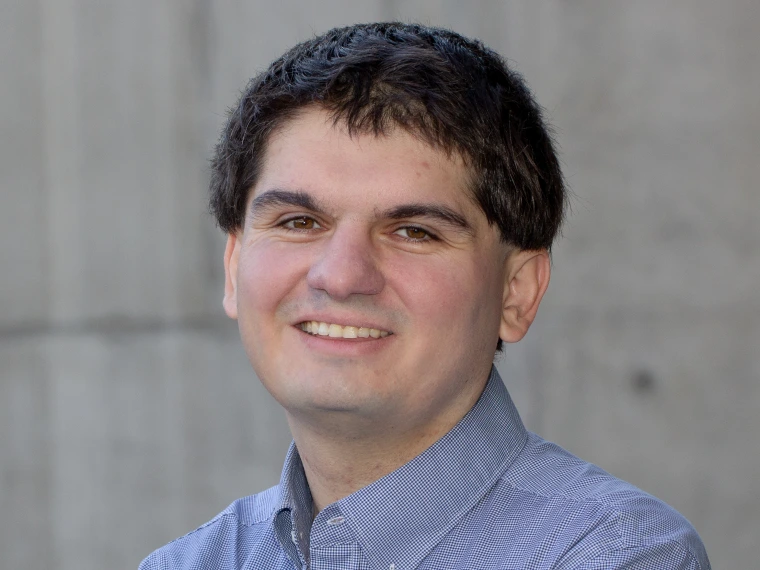Speakers
Speakers’ bios and abstracts below appear in order of their presentation according to the agenda.
Underneath student names is a link to a very short survey to review their presentation. We strongly encourage Industrial Affiliates members to complete these short surveys to give feedback to the students.
Workshop Presenters
Five-Minute Rapid Fire Presenters
Lab Tours
Poster Presenters
Workshop Presenters
Keynote Speaker
Cat Merrill
Title:
Optics Clusters: Engines of Regional Growth
Abstract:
TBD
Bio:
TBD
Cristian Panda, Assistant Professor of Optical Sciences
Title:
Quantum Metrology and Sensing using Atoms and Molecules
Abstract:
Exceptional levels of quantum control and coherence are necessary for performing quantum metrology and sensing with the utmost precision. Atom interferometers are powerful in both probing fundamental physics and everyday sensing, with results that range from the measurement of fundamental constants and tests of general relativity to the quantum sensing of gravity and inertial effects in the field for geophysical, defense and industrial applications. However, the use of atoms in free fall has so far limited their measurement times to a few seconds.
Bio:
Cristian Panda is an Assistant Professor at the Wyant College of Optical Sciences (OSC) at the University of Arizona. He received his undergraduate degree in Physics from Reed College with his thesis titled “The role of delay in the isochronal chaos synchronization of delay-coupled opto-electronic oscillators”. He then earned his A.M. and Ph.D. at Harvard University searching for physics beyond the Standard Model as part of the ACME experiment, where he measured the electron’s electric dipole moment with record precision enabled by the huge electric field available in the thorium monoxide molecule. From 2019 to 2024, he was a postdoctoral scholar at the University of California Berkeley, where he developed an interferometer with atoms held against Earth’s gravity by an optical lattice. This device was able to achieve quantum coherence beyond the minute scale and record sensitivity to measuring exotic dark energy candidate fields. Dr. Panda is an APS DAMOP Deborah Jin Thesis Prize Finalist, 2021, and has received the Purcell Fellowship, Harvard University, 2012-2013. He has authored over 20 peer-reviewed publications in journals such as Nature, Science, Physical Review, Applied Physics Letters, Journal of Physics and others. His community involvement includes multiple organization memberships, acting as a reviewer for a wide range of academic journals, as well as mentoring and teaching students outside of the classroom at all levels, including undergraduate, high school and middle school.
Mark Spencer, Robert M. Edmund Endowed Chair in Optical Sciences, Professor of Optical Sciences

Title:
High Energy Laser Perspectives from a Former Government Leader and Current Academic Researcher
Abstract:
Since 2019, the Military Services have developed several high energy laser (HEL) prototype systems in support of the near- and mid-term goals of the Department of War Directed Energy Roadmap. Currently, the most sophisticated prototypes under development are the HEL Counter Anti-ship-cruise-missile Program (HELCAP) being funded by the Office of Naval Research and the Indirect Fire Protection Capability HEL (IFPC-HEL) being funded by the U.S. Army’s Rapid Capabilities and Critical Technologies Office. Both prototypes are scheduled for field demos in FY26 in support of Golden Dome for America. Based on lessons learned from HELCAP and IFPC-HEL, one significant challenge that remains for future prototype systems is the timely integration of continuous-wave HEL sources at >100 kW-class power levels. A lot of these integration challenges can be overcome with enough time and funding; however, they can also be overcome with innovation. Either option will require an experienced workforce, and that is the point of this talk—to start a discussion on how the University of Arizona can help our industrial affiliates with respect to this cause.
Bio:
Mark F. Spencer is a Professor of Optical Sciences and the inaugural holder of the Robert M. Edmund Endowed Chair in Optical Sciences within the James C. Wyant College of Optical Sciences at the University of Arizona. At large, he is a scientist/engineer who has spent his career working in various technical and administrative capacities. Mark began his career at the Air Force Research Laboratory, Directed Energy Directorate (2014-2021) after receiving his PhD from the Air Force Institute of Technology as a SMART Scholar. Before taking his current role in academia, he served as a Directed Energy Staff Specialist at Headquarters US Indo-Pacific Command (2021-2023), as well as Director of the Joint Directed Energy Transition Office and Principal Director (Senior Official) for Directed Energy within the Office of the Under Secretary of Defense for Research and Engineering at the Pentagon (2023-2025). Mark is an internationally recognized expert in directed energy (specifically, beam control and propagation for laser systems) and currently conducts research in unconventional imaging, sensing, and adaptive optics for defense and commercial applications. He is a Senior Member of Optica and a Fellow of SPIE.
Yeran Bai, Assistant Professor of Optical Sciences

Title:
Uncovering single cell function with mid infrared photothermal microscopy
Abstract:
TBD
Bio:
TBD
Five-Minute Rapid Fire Presenters
| Presentation Time | Presenter – First Name | Presenter – Last Name | 5-Minute Rapid Fire Presentation Title |
Lab Tours
Image Science
Optical Engineering
Optical Physics
Photonics


